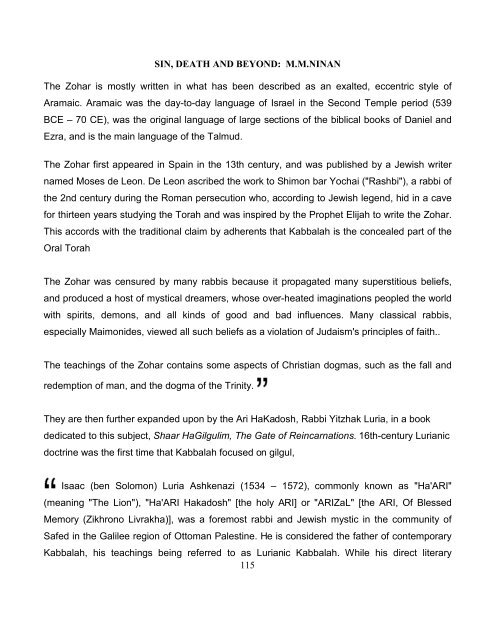Sin death and beyond
Create successful ePaper yourself
Turn your PDF publications into a flip-book with our unique Google optimized e-Paper software.
SIN, DEATH AND BEYOND: M.M.NINAN<br />
The Zohar is mostly written in what has been described as an exalted, eccentric style of<br />
Aramaic. Aramaic was the day-to-day language of Israel in the Second Temple period (539<br />
BCE – 70 CE), was the original language of large sections of the biblical books of Daniel <strong>and</strong><br />
Ezra, <strong>and</strong> is the main language of the Talmud.<br />
The Zohar first appeared in Spain in the 13th century, <strong>and</strong> was published by a Jewish writer<br />
named Moses de Leon. De Leon ascribed the work to Shimon bar Yochai ("Rashbi"), a rabbi of<br />
the 2nd century during the Roman persecution who, according to Jewish legend, hid in a cave<br />
for thirteen years studying the Torah <strong>and</strong> was inspired by the Prophet Elijah to write the Zohar.<br />
This accords with the traditional claim by adherents that Kabbalah is the concealed part of the<br />
Oral Torah<br />
The Zohar was censured by many rabbis because it propagated many superstitious beliefs,<br />
<strong>and</strong> produced a host of mystical dreamers, whose over-heated imaginations peopled the world<br />
with spirits, demons, <strong>and</strong> all kinds of good <strong>and</strong> bad influences. Many classical rabbis,<br />
especially Maimonides, viewed all such beliefs as a violation of Judaism's principles of faith..<br />
The teachings of the Zohar contains some aspects of Christian dogmas, such as the fall <strong>and</strong><br />
redemption of man, <strong>and</strong> the dogma of the Trinity.<br />
They are then further exp<strong>and</strong>ed upon by the Ari HaKadosh, Rabbi Yitzhak Luria, in a book<br />
dedicated to this subject, Shaar HaGilgulim, The Gate of Reincarnations. 16th-century Lurianic<br />
doctrine was the first time that Kabbalah focused on gilgul,<br />
Isaac (ben Solomon) Luria Ashkenazi (1534 – 1572), commonly known as "Ha'ARI"<br />
(meaning "The Lion"), "Ha'ARI Hakadosh" [the holy ARI] or "ARIZaL" [the ARI, Of Blessed<br />
Memory (Zikhrono Livrakha)], was a foremost rabbi <strong>and</strong> Jewish mystic in the community of<br />
Safed in the Galilee region of Ottoman Palestine. He is considered the father of contemporary<br />
Kabbalah, his teachings being referred to as Lurianic Kabbalah. While his direct literary<br />
115


















